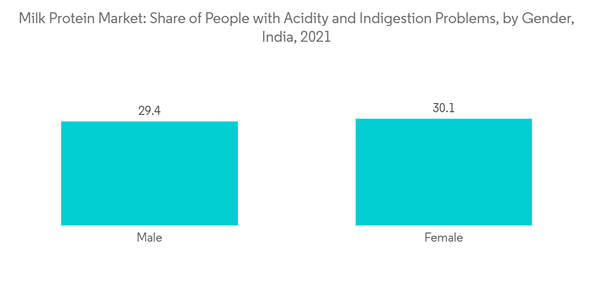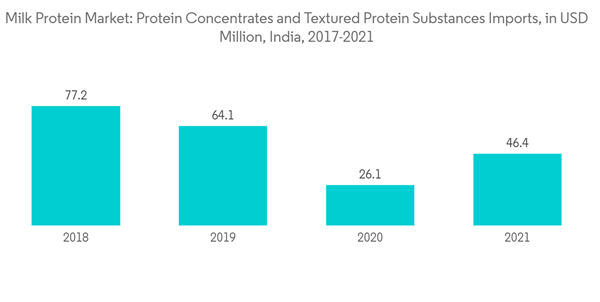Key Highlights
- Milk protein demand in India has been consistently strong due to its essential nutritional properties and widespread use in various food and beverage products. Milk proteins are valued for their high-quality amino acid profile, which makes them a complete protein source, containing all essential amino acids required by the human body. They are crucial in muscle growth, repair, and overall health. Additionally, consumers are becoming more health-conscious and seeking nutrient-dense food options, and in line with this, milk proteins are perceived as natural and healthy sources of protein compared to some processed alternatives. Hence, manufacturers in India often add it to high-protein foods and supplements as a cost-effective way to increase their protein content with little effect on flavor, which is driving its usage in the country.
- Additionally, consumption of the milk protein type in India is mainly led by the food and beverage segment, more particularly by the snacks, bakery, and dairy and dairy alternatives sub-segments. Milk proteins perform numerous critical functions in preparing products in these sub-segments, such as emulsification, thickening, gelling, and foaming. The ability to enhance the development and stabilization of oil droplets in emulsions is a crucial role played by milk proteins in food colloids. As a result, it is frequently used as an ingredient in various manufactured food colloids, including dairy desserts, nutritive drinks, ice cream, yogurt, spreads, confections, and baked products.
- Also, food and beverage manufacturers in the country are focused on developing innovative products by incorporating milk proteins which are expected further to drive the demand for milk proteins in the country. For instance, in February 2023, The scientists of the National Dairy Research Institute developed a 'Milk Protein-Enriched Millet Biscuits' and launched the product for sale at NDRI Milk Parlour. The manufacturer also claimed that several new milk-millet-based food products would soon be launched at the milk parlor. With such innovations happening in the country's market, it is expected that the players will have various opportunities to develop innovative milk proteins that can have multiple application capabilities to cater to different industries and manufacturers.
India Milk Protein Market Trends
Increasing Heath Concerns are Boosting the Demand for Milk Protein
- The high prevalence of digestive disorders and malnutrition in the country has boosted the demand for products with a significant content of milk protein, thus driving its demand. Products like different types of cheese, including cottage cheese, cream cheese, different types of milk, yogurt, and butter, among others, contain high levels of milk proteins and are highly consumed in the Indian market, thus driving the market's growth. For instance, according to the USDA Foreign Agricultural Service, as of 2022, the total domestic consumption volume of milk was over 203 million metric tons in India. This was an increase as compared to the previous year when the consumption volume was about 199 million metric tons.
- Similarly, yogurt is an example of a probiotic milk drink that is available in both drinkable form and in the traditional form - in different flavors, making it one of the most preferred food products by consumers who are seeking products that provide benefits to their digestive health. Manufacturers add Milk Protein Concentrate (MPC) to yogurt as functional ingredients, as they are sometimes erroneously referred to as 'stabilizers.' Additionally, incorporating milk protein into yogurt and other such health-benefit products can enhance the functionality of the product apart from improving the product's shelf life.
- Moreover, consumers increased usage of products with milk proteins is attributed to their features to offer digestive enzymes to prevent bowel symptoms (such as gas, bloating, and abdominal discomfort) which is supporting the market's growth. For instance, according to GOQii, as per the results of a large-scale survey conducted across India in 2021, about 30% of female respondents reported acidity and indigestion problems. Whereas about 29% of male respondents had gut-related problems in that year. With such a situation in India, manufacturers are focused on launching fortified food and beverage products with milk proteins claiming that they can benefit the gut and digestive system while addressing other health concerns.
- For instance, in August 2021, Lactalis India, part of France's Lactalis Group, forayed into the yogurt category in India by launching Lactel Turbo Yoghurt Drink. The company claimed that this is the first such drink in India that is incorporated with milk proteins containing all the benefits of all-natural premium French quality yogurt. Such innovations are expected to increase the usage and demand of milk proteins in the country, thus driving the market's growth during the forecast period.
Milk Protein Concentrates Accounts for the Largest Share in the Market
- Milk protein concentrate (MPC) is usually produced using membrane technology, and it often contains both casein and whey proteins which enables manufacturers to claim the benefits of these ingredients. They often come with higher protein content compared to other ingredients and are also lower in price, making them ideal for manufacturers to use in their applications. In India, milk protein concentrates are available in a range of protein levels from 42 to 85%, with the lactose level falling as the protein level increases. Additionally, milk protein concentrates can be used for its nutritional and functional properties. The high protein, low lactose ratio makes MPC suitable for protein-fortified beverages and low-carbohydrate foods.
- Moreover, milk protein concentrates (MPCs) have emerged over the past two decades as significant new dairy ingredients that are used increasingly in food formulation and nutritional beverages. Various factors like longer shelf life, convenience, rich flavor and texture, versatility in cooking, economic value, and easy storage and transportation have also been supporting the usage and growth of milk protein concentrates in the country. Milk concentrates have a significantly longer shelf life compared to regular milk. The process of condensing or evaporating milk removes a substantial amount of water, reducing its perishability and allowing it to be stored without refrigeration for an extended period. Due to their concentrated nature, milk concentrates take up less space than regular milk, making them easier to store and transport in bulk.
- Furthermore, milk concentrates are more affordable than other dairy products, making them an attractive option for manufacturers, thus aiding the segment's growth in the region. For instance, the demand for protein concentrates in India can be depicted by the growing imports into the country. For instance, according to UN Comtrade, the imports of protein concentrates and textured protein substances were almost USD 46.4 million in 2021, which increased from USD 26.1 million when compared to the previous year. Such factors, coupled with the growing demand, are expected to boost the segment's growth during the forecast period, thus contributing to the overall market growth in the country.
India Milk Protein Industry Overview
The India Milk Protein Market is fragmented, with many players trying to expand their services and presence in the country owing to the growing demand. The major players in this market are Dindigul Farm Product Private Limited (EnNutrica), Fonterra Co-operative Group Limited, Glanbia PLC, Royal FrieslandCampina NV, and Titan Biotech. Several small and international players are involved in the manufacturing and distribution of milk protein ingredients in the country. Furthermore, companies engage in capacity expansions, strategic partnerships, product portfolio expansions, and mergers & acquisitions to gain a competitive edge.Additional Benefits:
- The market estimate (ME) sheet in Excel format
- 3 months of analyst support
This product will be delivered within 2 business days.










